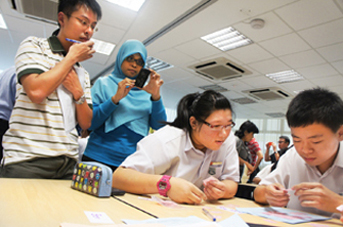Why Singapore’s English Teachers Should Embrace Singlish, Not Fight It
Is it time for Singaporean educators to embrace Singlish as a legitimate learning tool? What the Research […]
Read More
by Lydia Tan-Chia
Who says English lessons need to be predictable? English teachers in seven project schools are beginning to realize lesson study’s flexibility as they work together to think through the design and delivery of English lessons.
Project En-ELT is an exploratory study by MOE’s English Language and Literature Branch, under the Curriculum Planning and Development Division, to support teachers in the learning and teaching of English Language in secondary schools.
Working closely with their School Advisers, the teachers gather in learning communities to analyse and rework research lessons. They have been studying the use of three research-based teaching strategies – Retelling, Process Writing and Reciprocal Teaching – and rich texts to connect teaching to learning in the classroom.
 These teaching strategies encapsulate the pedagogical content knowledge for the teachers. As students work on the product and processes of the various tasks, they not only strengthen their skills in all areas of language learning. For onlookers, this process makes learning visible in the classroom.
These teaching strategies encapsulate the pedagogical content knowledge for the teachers. As students work on the product and processes of the various tasks, they not only strengthen their skills in all areas of language learning. For onlookers, this process makes learning visible in the classroom.
Melding this with Assessment for Learning (AfL) principles into daily classroom practice, the aim of this project is to facilitate the development of reading and writing skills, as well as speaking, critical listening, critical-inventive thinking and metacognition in students.
The roles within each team are defined yet flexible, but subject matter leadership is assumed by the Head of Department, Level Head or Instructional Leader in the group. The research lesson usually takes off from a prototype first put together by the group leader or a key teacher in the group.
The research lesson is situated in a unit of work but is selected for its potential to exemplify key steps of the teaching strategy. Teachers work with one key strategy per semester in one lesson study cycle. The duration of the lesson study cycle, of approximately a week or slightly more, is adapted to coincide with the unit of work as defined in the scheme of work.
The agenda during instructional planning is curriculum driven. It is guided largely by the intention to enact the teaching strategy and to master its basic steps, on one hand, and the desire to incorporate AfL practices (e.g., Socratic questioning), structure consolidation and gather feedback, on the other.
The corrections and suggestions from the group discussion are usually taken on board. It is about incorporating what is most appropriate for student learning at strategic moments. The central documents used are two highly portable resources: an instructional planning tool and a piece of rich text.
A teacher volunteers to deliver Research Lesson One (RL1). It is recommended that the more experienced teacher lead the way, though it does not always happen. Then comes the moment of discovery, a moment that has been aptly captured by Takahashi when he noted: “Good teaching is very easy to talk about, but very hard to do” (in Lewis & Hurd, 2011, p. 77).
– Lydia Tan-Chia , Ministry of Education
The lesson observation allows teachers to see how theoretical constructs transition from planning to enactment in a live classroom. Their proximity to the students allows them to notice the effect of the lesson on student learning. That remains the heart of lesson study: student learning and student work.
Then, armed with evidence of student learning, the post-lesson colloquium allows the teachers to turn the teaching strategy inside out. The colloquia occur within the same day of the observation. The immediacy of the classroom experience lends vigour to the analysis of the lesson.
Guided by the protocol recommended by Catherine Lewis, the group analyses each segment of the lesson. Their findings are substantiated with evidence of student learning and the AfL moments seized by the RL teacher. The RL teacher might also bring artefacts from students’ class work, which becomes another source of evidence and discovery.
At the end of the exchange, the Instructional Leader will sum up the key learning points. These are quickly spun into propositions for future practice. The colloquia end with agreement on the areas for improvement, which will be worked into a replay of the lesson at Research Lesson Two (RL2) by another teacher in the group.
If the lesson study cycle stops at RL1, the proposed refinements to the curriculum will remain as theoretical constructs.
With RL2, the focus is on testing out the efficacy of the improved curriculum features and teaching strategies on the students. Observing the enactment of RL2 offers a contrastive perspective of the teaching strategy, with its alternatives and possibilities, which in turn animates the teachers’ collaborative learning.
Teachers come to realize that so much can happen by just being in one another’s classrooms and studying one another’s students. Improvements are carried out while they are still meaningful, and the juxtaposition of good practices can also sway the doubting Thomas in the group.
As for MOE, more discoveries await as we continue to closely study lessons together with the teachers, to uncover student learning of the English language in the Singapore classroom.
References
Lewis, C. C. (2002). Lesson study: A handbook of teacher-led instructional change. USA: Mid-Atlantic Eisenhower Regional Consortium for Mathematics and Science Education.
Lewis, C. C., & Hurd, J. (2011). Lesson study step by step: How teacher learning communities improve instruction. USA: Heinemann.